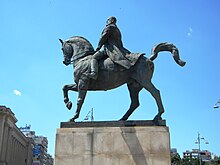
Peleș Castle is a Neo-Renaissance palace in the Royal Domain of Sinaia in the Carpathian Mountains, near Sinaia, in Prahova County, Romania, on an existing medieval route linking Transylvania and Wallachia, built between 1873 and 1914. Its inauguration was held in 1883. It was constructed for King Carol I of Romania.

The Senate is the upper house in the bicameral Parliament of Romania. It has 136 seats, to which members are elected by direct popular vote using party-list proportional representation in 43 electoral districts, to serve four-year terms.

The Victoria Palace is a government building on the large Victory Square in Bucharest, housing the Prime Minister of Romania and his cabinet.

Telephones Company Building is an Art Deco office building located on Calea Victoriei in Bucharest, Romania. It is now owned by Telekom România.

The Royal Palace of Bucharest, known as Palace of the Republic between 1948 and 1990, is a monumental building situated in the capital of Romania, on Calea Victoriei. The palace in its various incarnations served as official residence for the kings of Romania until 1947, when the communist regime was installed after Michael I of Romania's forced abdication. Since 1950, the palace hosts the National Museum of Art of Romania. The Romanian royal family currently uses Elisabeta Palace as its official residence in Bucharest. In addition, the Romanian government allows the royal family to use the Royal Palace different occasions.
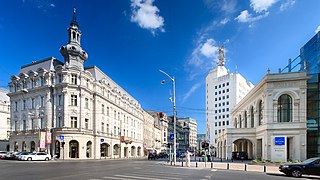
Calea Victoriei is a major avenue in central Bucharest. Situated in Sector 1, and having a length of 2.7 kilometres (1.7 mi), it leads from Splaiul Independenței to the north and then northwest up to Piața Victoriei, where Șoseaua Kiseleff continues north.
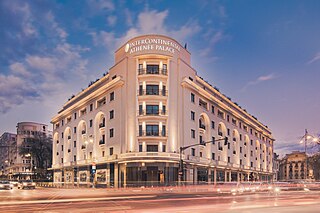
The InterContinental Athénée Palace Bucharest is a historic luxury hotel in Bucharest, Romania, originally opened in 1914. It was arguably Europe's most notorious den of spies in the years leading up to World War II, and only slightly less so during the Cold War.

Charles de Gaulle Square is a square in northern Bucharest, Romania. It lies at the intersection of Aviatorilor, Constantin Prezan and Primăverii Boulevards, and Calea Dorobanților.
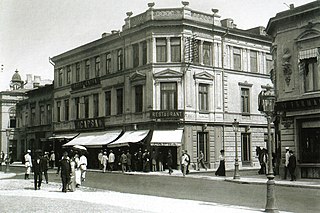
Casa Capșa is a historic restaurant in Bucharest, Romania, first established in 1852. At various times it has also included a hotel; most recently, it reopened as a 61-room hotel 17 June 2003. "...long a symbol of Bucharest for its inhabitants... Capșa is not only associated with its exquisite pastry products, but also for a hectic literary life of yore... a welcoming place for Romanian writers where they could meet, talk and...associate."

Carol I Park is a public park in Bucharest, Romania, named after King Carol I of Romania. A French garden located in the southern-central area of Bucharest, partly on Filaret Hill, originally capable of hosting various exhibitions, it suffered considerable modifications during the communist regime, including a name change to Parcul Libertății.

Victory Square is one of the major public squares in Bucharest, Romania, an intersection where Calea Victoriei, Lascăr Catargiu Boulevard, Iancu de Hunedoara Boulevard, Kiseleff Boulevard, Ion Mihalache Boulevard, and Nicolae Titulescu Boulevard cross.
Revolution Square is a square in central Bucharest, on Calea Victoriei. Known as Palace Square until 1989, it was renamed after the Romanian Revolution of December 1989. The former Royal Palace, the Athenaeum, the Athénée Palace Hotel, the University of Bucharest Library and the Memorial of Rebirth are located here. The square also houses the building of the former Central Committee of the Romanian Communist Party. In 1990, the building became the seat of the Senate and since 2006 it houses the Ministry of Interior and Administrative Reform.
Romanian architecture is very diverse, including medieval, pre-World War I, interwar, postwar, and contemporary 21st century architecture. In Romania, there are also regional differences with regard to architectural styles. Architecture, as the rest of the arts, was highly influenced by the socio-economic context and by the historical situation. For example, during the reign of King Carol I (1866–1914), Romania was in a continuous state of reorganization and modernization. In consequence, most of the architecture was designed by architects trained in Western European academies, particularly the École des Beaux-Arts, and a big part of the downtowns of the Romanian Old Kingdom were built during this period.
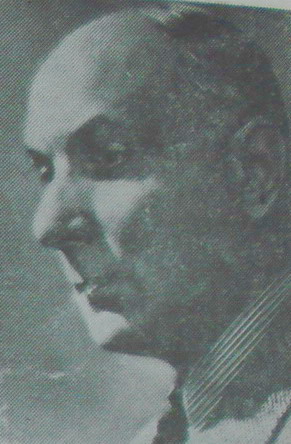
Duiliu Marcu was a Romanian architect, one of the most well known and prolific of the interwar period. With a career spanning from 1912 to 1966, he is said to have designed 150 public and private projects across Romania, his work reflecting the evolution of local architecture in the first half of the 20th century from French Renaissance, though Neo-Romanian to modernism. Though also designing private villas and apartments, he designed some of the major interwar public buildings in the country, including the Timișoara Theatre, the Elisabeth Palace in Bucharest for the royal family, and the Victory Palace, which now houses the office of the Prime Minister.

Calea Moșilor is both a historic street and a major road in Bucharest, Romania. It runs from the back of the Cocor Shopping Mall to Obor.
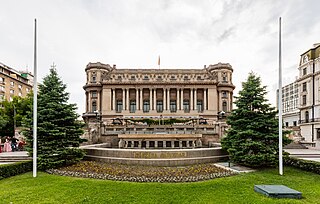
The Palace of the National Military Circle, also known as the Officers' Circle Palace is located on Constantin Mile street in Bucharest, Romania. It was built in 1911, based on plans drawn by chief architect Dimitrie Maimarolu, using French neoclassical style. The beneficiary was the Officers' Circle of the Bucharest military garrison, which was founded in 1876.

Alexandru Săvulescu (1847–1902) was a Romanian architect, one of his country's first prominent practitioners of modern architecture. He combined elements of traditional Byzantine architecture and Romanian architecture with French Art Nouveau in an eclectic style. He served as the chief architect for the Ministry of Public Education and Religious Affairs and the president of the Romanian Society of Architects. He helped found both the latter organization and the Romanian National School of Architecture. Some of his most renowned buildings are the Communal Palace of Buzău, the Noblesse Palace and the Post and Telegraph Palace, which now houses the National Museum of Romanian History.

The Michael the Brave 30th Guards Brigade is a primarily ceremonial, as well as combat unit of the Romanian Armed Forces established in 1990. The Brigade also has a military music band, a drill team detachment, and an artillery battery. The military police unit of the Brigade guards certain special objectives of Bucharest. The Brigade traces its origins to the 1st Tirailleur Battalion, later Vânători Battalion, which was established in 1860.
The 1918 Romanian typographers' strike was a labor strike in Bucharest, Romania. The strike began on December 6, 1918, when the city's typographers went on strike for higher salaries, an 8-hour work day, and recognition of their union. The striking workers declared a second protest the following week, and on December 13, they were joined by various left-wing groups, who demanded the abolition of the Romanian monarchy. It is estimated that over 15,000 participated in the December 13th demonstrations. The strike was violently put down by the Romanian military, resulting in the deaths and injuries of dozens of workers, although the death toll has been disputed.
